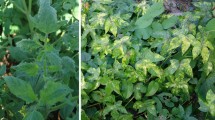Abstract
At least six begomovirus species have been reported infecting tomato in Venezuela. In this study the complete genomes of two tomato-infecting begomovirus isolates (referred to as Trujillo-427 and Zulia-1084) were cloned and sequenced. Both isolates showed the typical genome organization of New World bipartite begomoviruses, with DNA-A genomic components displaying 88.8% and 90.3% similarity with established begomoviruses, for isolates Trujillo-427 and Zulia-1084, respectively. In accordance to the guidelines for begomovirus species demarcation, the Trujillo-427 isolate represents a putative new species and the name “Tomato wrinkled mosaic virus” is proposed. Meanwhile, Zulia-1084 represents a putative new strain classifiable within species Tomato chlorotic leaf distortion virus, for which a recombinant origin is suggested.

Similar content being viewed by others
References
Argüello-Astorga GR, Ruiz-Medrano R (2001) An iteron-related domain is associated to Motif 1 in the replication proteins of geminiviruses: identification of potential interacting amino acid-base pairs by a comparative approach. Arch Virol 146:1465–1485
Briddon RW, Patil BL, Bagewadi B, Nawaz-ul-Rehman MS, Fauquet CM (2010) Distinct evolutionary histories of the DNA-A and DNA-B components of bipartite begomoviruses. BMC Evol Biol 10:97
Brown JK, Zerbini FM, Navas-Castillo J, Moriones E, Ramos-Sobrinho R, Silva JCF, Fiallo-Olivé E, Briddon RW, Hernández-Zepeda C, Idris A, Malathi VG, Martin DP, Rivera-Bustamante R, Ueda S, Varsani A (2015) Revision of begomovirus taxonomy base on pairwise sequence comparisons. Arch Virol 160:1593–1619
Collins A, Rehman MM, Chowda-Reddy RV, Wang A, Fondong V, Brown J, Roye M (2010) Molecular characterization and experimental host range of an isolate of Macroptilium golden mosaic virus that infects Wissadula amplissima in Jamaica. Virus Res 150:148–152
Edgar RC (2004) MUSCLE: multiple sequence alignment with high accuracy and high throughput. Nucleic Acids Res 32:1792–1797
Fiallo-Olivé E, Márquez-Martín B, Hassan I, Chirinos DT, Geraud-Pouey F, Navas-Castillo J, Moriones E (2013) Complete genome sequences of two novel begomoviruses infecting common bean in Venezuela. Arch Virol 158:723–727
Geraud-Pouey F, Chirinos DT, Galindo-Castro I, Franco MA, Santana MA, Gillis A, Romay G (2016) Occurrence of six begomoviruses infecting tomato fields in Venezuela and genetic characterization of Potato yellow mosaic virus isolates. J Phytopathol 164:697–703
Gilbertson RL, Batuman O, Webster CG, Adkins S (2015) Role of the insect supervectors Bemisia tabaci and Frankliniella occidentalis in the emergence and global spread of plant viruses. Annu Rev Virol 2:67–93
Gilbertson RL, Rojas MR, Russell DR, Maxwell DP (1991) Use of the asymmetric polymerase chain reaction and DNA sequencing to determine genetic variability of bean golden mosaic geminivirus in the Dominican Republic. J Gen Virol 72:2843–2848
Hall TA (1999) BioEdit: a user-friendly biologically sequence alignment editor and analysis program for windows 95/98/NT. Nucleic Acids Symp Ser 41:95–98
Hanssen IM, Lapidot M, Thomma BP (2010) Emerging viral diseases of tomato crops. Mol Plant Microbe Interact 23:539–548
Hernández-Zepeda C, Idris AM, Carnevali G, Brown JK, Moreno-Valenzuela OA (2007) Molecular characterization and phylogenetic relationships of two new bipartite begomovirus infecting malvaceous plants in Yucatan, Mexico. Virus Genes 35:369–377
Lole KS, Bollinger RC, Paranjape RS, Gadkari D, Kulkarni SS, Novak NG, Ingersoll R, Sheppard HW, Ray SC (1999) Full-length human immunodeficiency virus type 1 genomes from subtype C-infected seroconverters in India, with evidence of intersubtype recombination. J Virol 73:152–160
Martin D, Murrell B, Golden M, Khoosa A, Muhire B (2015) RDP4: detection and analysis of recombination patterns in virus genomes. Virus Evol 1:vev003
Muhire BM, Varsani A, Martin DP (2014) SDT: a virus classification tool based on pairwise sequence alignment and identity calculation. PLoS One 9:e108277
Rojas MA, Gilbertson RL, Russell DR, Maxwell DP (1993) Use of degenerate primers in the polymerase chain reaction to detect whitefly-transmitted geminiviruses. Plant Dis 77:340–347
Rojas A, Kvarnheden A, Marcenaro D, Valkonen JP (2005) Sequence characterization of tomato leaf curl Sinaloa virus and tomato severe leaf curl virus: phylogeny of New World begomoviruses and detection of recombination. Arch Virol 150:1281–1299
Romay G, Geraud-Pouey F, Chirinos DT, Morales F, Herrera E, Fernández C, Martínez AK (2010) Transmisión del tomato Venezuela virus por Bemisia tabaci (Gennadius) (Hemiptera: Aleyrodidae), en Maracaibo, Venezuela. Neotrop Entomol 39:266–274
Romay G, Geraud-Pouey F, Chirinos D, Demey J (2016) Bemisia tabaci (Gennadius) (Hemiptera: Aleyrodidae): Historia, situación actual y su rol como vector de enfermedades virales de plantas en Venezuela. Entomotropica 31:276–293
Samuels J (2015) Biodiversity of food species of the Solanaceae family: a preliminary taxonomic inventory of subfamily Solanoideae. Resources 4:277–322
Tamura K, Stecher G, Peterson D, Filipski A, Kumar S (2013) MEGA6: molecular evolutionary genetics analysis version 6.0. Mol Biol Evol 30:2725–2729
Zambrano K, Geraud-Pouey F, Chirinos D, Romay G, Marys E (2011) Tomato chlorotic leaf distortion virus, a new bipartite begomovirus infecting Solanum lycopersicum and Capsicum chinense in Venezuela. Arch Virol 56:2263–22636
Acknowledgements
This study was partly supported by Grant FONACIT-G-2000001610 of the Venezuelan Ministry of Higher Education, Science and Technology. G.R. is a Move-In Louvain postdoctoral fellow of the Université catholique de Louvain. A.G. holds a Chargé de Recherches fellowship from the National Fund for Scientific Research (FNRS).
Author information
Authors and Affiliations
Corresponding author
Ethics declarations
Conflict of interest
The authors declare no conflict of interest.
Ethical approval
This article does not contain any studies with human participants or animals performed by any of the authors.
Additional information
Handling Editor: F. Murilo Zerbini.
Electronic supplementary material
Below is the link to the electronic supplementary material.



Rights and permissions
About this article
Cite this article
Romay, G., Chirinos, D.T., Geraud-Pouey, F. et al. Complete genome sequence of two tomato-infecting begomoviruses in Venezuela: evidence of a putative novel species and a novel recombinant strain. Arch Virol 163, 555–558 (2018). https://doi.org/10.1007/s00705-017-3611-y
Received:
Accepted:
Published:
Issue Date:
DOI: https://doi.org/10.1007/s00705-017-3611-y




